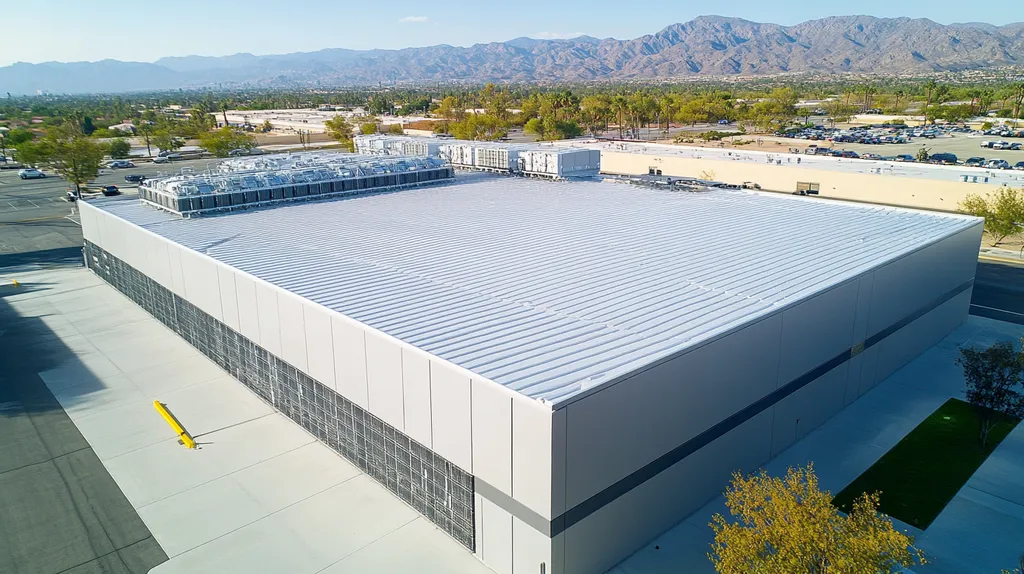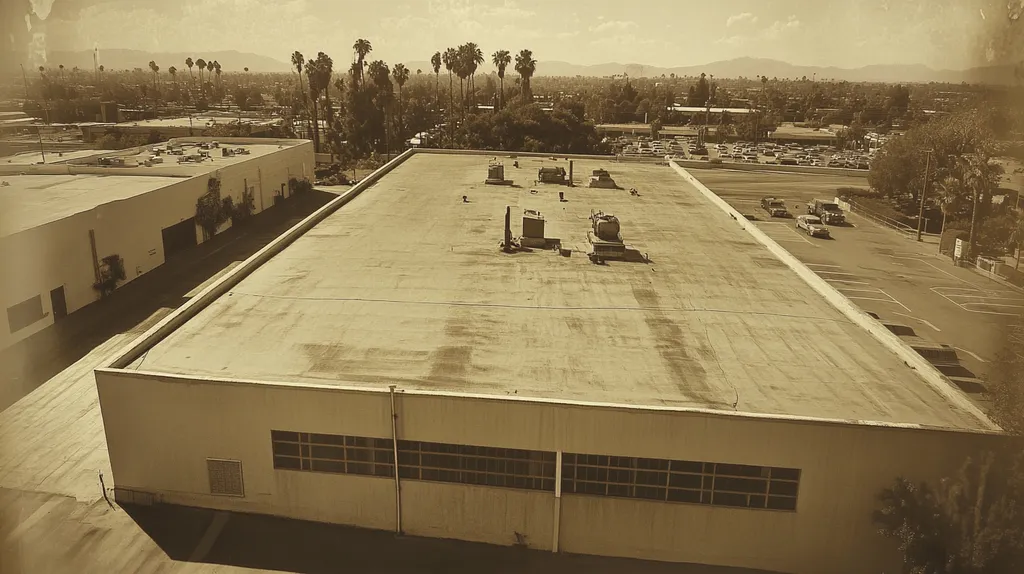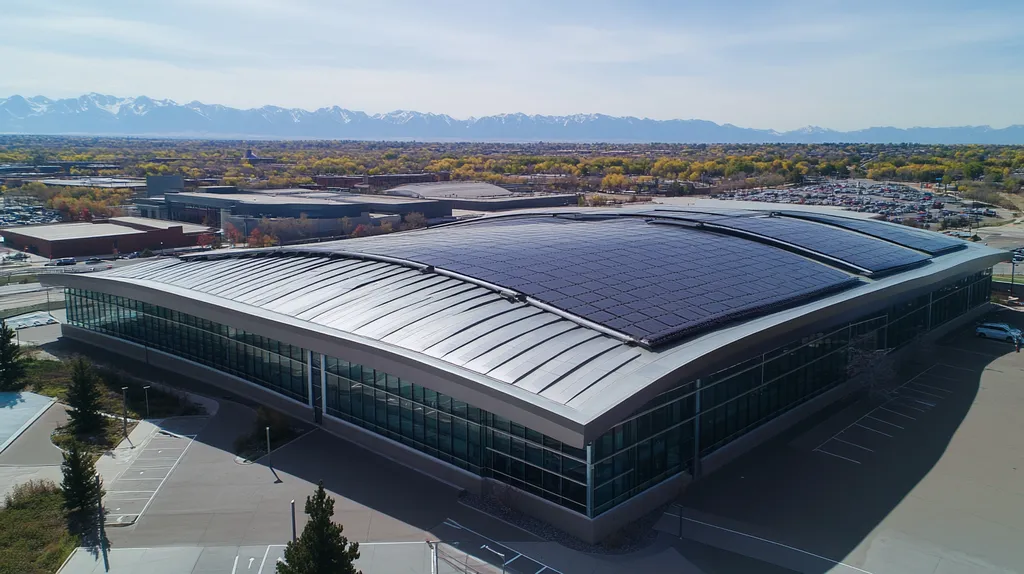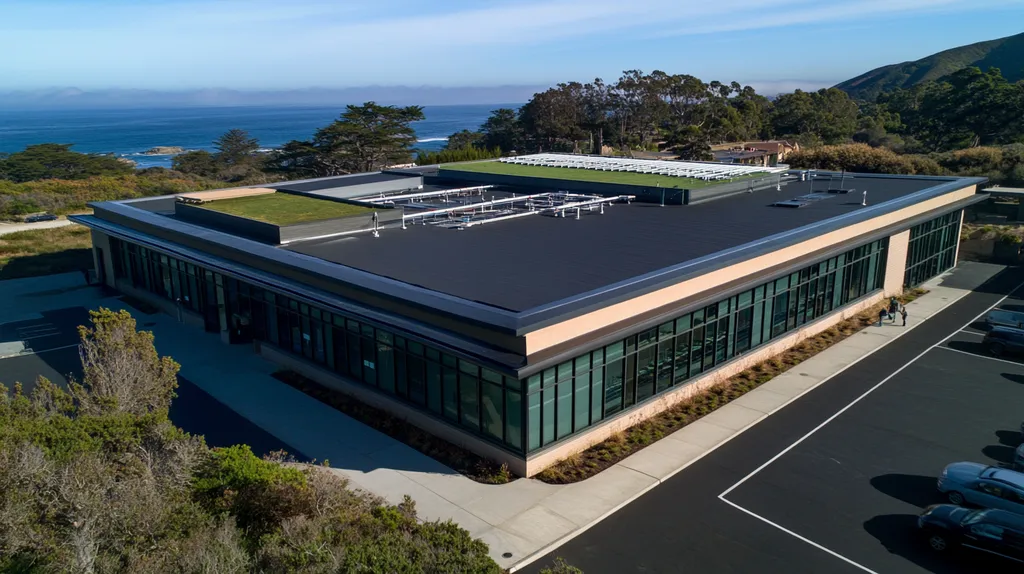In an era where 30% of industrial roofs fail prematurely, facility managers can no longer afford to rely solely on traditional roofing materials. The stakes are extraordinarily high, with a single roof failure potentially causing millions in damage to equipment and inventory.
Modern alternatives to conventional roofing materials offer groundbreaking solutions in durability, energy efficiency, and cost-effectiveness. From innovative synthetics like TPO to sustainable options like green roofing systems, these alternatives are revolutionizing industrial building protection.
This comprehensive guide examines the critical factors facility managers must understand when considering roofing alternatives, from material selection to long-term performance implications.
SECTION 1: THE BASICS EXPLAINED
As energy prices soar and weather extremes become more frequent, industrial property owners face an urgent challenge: re-evaluating traditional roofing materials. Alarmingly, over 30% of industrial roofs fail before their time, resulting in hefty repair bills and interruptions in production. Understanding the available alternatives is crucial for enhancing long-term building performance, energy efficiency, and environmental responsibility. This section delves into what these alternatives are, why they matter for your building, and how they operate.
What It Is (In Plain Language)
Industrial roofing alternatives are cutting-edge materials and systems that surpass conventional choices like asphalt and metal. Popular options include thermoplastic polyolefin (TPO), ethylene propylene diene terpolymer (EPDM), and green roofing systems. Each alternative is engineered to offer enhanced durability, energy efficiency, and ecological advantages.
TPO, for instance, is favored for its exceptional energy efficiency, effectively reflecting sunlight to decrease cooling expenses. Meanwhile, EPDM shines in its durability, resisting adverse weather and UV exposure. Green roofs, which incorporate live plants, serve dual purposes: insulating buildings and absorbing rainwater, thereby alleviating drainage challenges.
Recognizing these alternatives empowers property owners to make strategic decisions that not only save money in the long run but also elevate property valuation. These choices ensure that industrial roofs meet the rigorous demands of modern performance and sustainability standards.
Why It Matters (To Your Building)
The choice of roofing material has a direct impact on both a building’s operational efficiency and its overall expenses. While traditional options might appear more cost-effective at first, they can lead to escalated costs in maintenance, energy consumption, and repairs. By opting for alternative materials, property owners can significantly mitigate these hidden expenses.
For example, facilities featuring reflective roofing can cut air conditioning costs by as much as 20%, saving substantial amounts, particularly in high-energy-cost areas. Moreover, innovative roofing solutions help buildings comply with increasingly stringent regulations on sustainability and energy efficiency.
Additionally, roofs constructed from modern materials like TPO and EPDM are engineered for resilience, enabling them to withstand severe conditions and last longer. The result? Less frequent replacements, which leads to reduced overall costs and interruptions to daily operations.
Thus, the decision regarding roofing materials extends far beyond mere appearance; it is pivotal in effective property management and sustainability efforts.
How It Works
Grasping the operational mechanics of alternative roofing materials is essential to recognizing their advantages. For instance, TPO roofing is applied as a single-ply membrane that welds together when exposed to heat, creating an effective watertight seal. This streamlined installation process not only cuts costs but also reduces time, providing quicker solutions for building owners.
EPDM functions in a similar way, leveraging its rubber-like flexibility to adapt to varying temperatures. Its installation, which can involve either adherence or mechanical fastening, makes it versatile across diverse architectural designs.
In contrast, green roofs feature multiple layers, consisting of vegetation, a growth medium, and a waterproof barrier. This design not only enhances insulation but also fosters local biodiversity and can improve urban air quality.
Understanding how these systems operate allows property managers to identify the best alternative roofing options for their facilities, ultimately leading to smarter, more economically sound decisions.
SECTION 2: PRACTICAL APPLICATIONS
In today’s fast-paced industrial landscape, the right roofing material can significantly influence a facility’s financial health and operational success. With energy prices climbing and environmental regulations tightening, turning to innovative roofing alternatives isn’t just wise—it’s essential. To illustrate the impact, studies reveal that energy-efficient roofing systems can reduce cooling costs by as much as 30%. This section will delve into practical applications, specific scenarios when these alternatives become crucial, and how they interact with existing building systems.
Common Uses & Examples
Alternative roofing materials are making their mark across a range of industrial settings, proving to be both versatile and efficient. Thermoplastic polyolefin (TPO) membranes are particularly popular for flat roofs, standing out for their impressive energy efficiency and robust performance. Green roofs, on the other hand, provide dual benefits by insulating buildings and managing stormwater effectively, showcasing how modern innovations can tackle multiple challenges at once.
EPDM (ethylene propylene diene monomer) rubber is another compelling choice, especially in facilities located in harsh climates, thanks to its superior durability. Meanwhile, standing seam metal roofs are an exceptional long-lasting option, famously low-maintenance and ideal for operations prioritizing structural resilience.
Each of these alternative roofing solutions offers unique features tailored to specific building needs. This variety empowers facility managers to choose the most suitable materials that not only meet operational demands but also bolster efficiency and sustainability throughout the organization.
When You Need It Most
The need for alternative roofing materials often becomes glaringly apparent when facilities start experiencing issues like an aging roof or soaring energy bills. Aging roofs signal that it’s high time to explore innovative materials that promise immediate savings, particularly on utility expenses.
Facilities frequently grappling with leaks or maintenance problems face a compelling case for re-evaluating their roofing choices. Such challenges don’t just disrupt operations; they can quickly lead to costly repairs, underlining the necessity of selecting materials known for their durability and reliability.
Moreover, any facility aiming to meet stringent environmental regulations will find significant advantages in these modern options. Reflective roofing materials, for example, help minimize heat absorption and enhance compliance with local sustainability standards.
Addressing roofing upgrades promptly prevents minor issues from spiraling into major disruptions. Understanding the right time to transition to alternative materials ensures facilities not only remain functional but also thrive competitively.
Interactions With Other Systems
It’s critical to evaluate how a new roofing material will interact with the existing building systems for a smooth integration. Properly assessing drainage and ventilation needs can dramatically boost the performance of alternative roofing solutions.
For instance, incorporating a green roof involves checking load-bearing capacities and ensuring effective drainage mechanisms are in place. Collaborating with roofing professionals during this decision-making process can yield valuable insights into these necessary interactions.
Additionally, energy-efficient roofing solutions often complement HVAC systems, contributing to reduced overall energy consumption. This synergy can lead to significant operational cost reductions and enhanced overall building performance.
By understanding how these new systems interact with existing infrastructure, facility managers can make informed choices that significantly enhance the effectiveness of their overall building systems. Embracing alternative roofing solutions fosters resource optimization, laying the foundation for sustainable operations.
SECTION 3: KEY TERMINOLOGY DECODED
For industrial property managers, grasping roofing terminology is not just useful—it’s essential. Misunderstanding key terms can lead to costly errors, especially when choosing alternative materials. For instance, recognizing “R-value” can have a significant impact on both energy efficiency and operational costs. This section breaks down essential roofing terminology, demystifies industry jargon, and clarifies measurements to empower more informed decisions throughout the roofing process.
Essential Terms Explained
Many roofing terms can appear confusing at first glance, yet they are vital for making informed choices. For example, “R-value” is a measure of insulation effectiveness, with higher values indicating improved thermal resistance. This directly affects energy efficiency and cost savings.
Another important term is “UV resistance,” which measures a material’s ability to withstand harmful ultraviolet rays. A high level of UV resistance helps prolong the lifespan of roofing materials, reducing the need for replacement.
“TPO,” or thermoplastic olefin, is a popular alternative roofing choice, celebrated for its impressive energy efficiency and cost-effectiveness. Familiarity with such terms enhances decision-making and facilitates clearer communication with contractors.
Lastly, “EPDM” stands for ethylene propylene diene monomer, a material noted for its exceptional durability and weather resistance. Understanding these critical terms not only aids in material selection but also enhances dialogue with roofing professionals.
Industry Jargon Translated
Industry jargon can be overwhelming for property managers, creating barriers to effective communication. For instance, the term “seam” refers to the overlap between two sections of roofing material, and proper seam construction is crucial for preventing leaks.
Another common term is “flashing,” which pertains to materials applied at roof junctions and transitions. Flashing is designed to direct water away from vulnerable areas, protecting against moisture intrusion.
“Ballasted roofs,” commonly associated with flat roof systems, use stones or pavers to hold the membrane in place. Understanding this concept helps prevent miscommunication regarding installation methods.
Additionally, the word “field” describes the main area of the roof, as opposed to its edges or penetrations. Familiarity with these terms can enhance discussions during both the planning and implementation phases.
Measurement & Units Simplified
Precise measurements are critical in roofing projects. Common units include square feet for measuring a roof’s surface area, and “squares,” where one square equals 100 square feet of roofing material.
Understanding “pitch” is equally important; it represents the angle of the roof, expressed as a ratio. For example, a pitch of 4:12 means the roof rises four inches for every twelve inches of horizontal run.
Moreover, “gauge” refers to the thickness of roofing materials, particularly metals. Knowledge of gauge measurements ensures the selection of appropriately durable products.
Lastly, recognizing “wind uplift” ratings is crucial for understanding how well a roofing system can withstand strong winds. Familiarity with these metrics leads to safer, more effective roofing solutions.
SECTION 4: DECISION FACTORS
Choosing the right roofing materials is a critical responsibility for industrial managers, where the stakes are high. The decision impacts not only operational costs but also safety and overall efficiency. With a wealth of alternatives to traditional materials available, it’s imperative to assess factors such as cost, performance, and durability carefully. Poor choices can lead to costly repairs, stressful production delays, and even safety risks.
Cost Considerations
Cost is typically the first thing managers consider when exploring roofing alternatives. While traditional options like asphalt or built-up roofs might appear cheaper initially, they often come with hefty long-term expenses. Newer materials like thermoplastic polyolefin (TPO) and ethylene propylene diene monomer (EPDM) offer more competitive pricing structures.
Furthermore, understanding the total cost of ownership is crucial. Initially lower costs do not always mean better deals; increased maintenance needs and complexity in installation can inflate expenses later. Managers must take into account the full lifecycle costs to make the most informed decisions.
Don’t overlook incentives and rebates offered for choosing sustainable roofing options. Many government programs aim to promote eco-friendly materials, effectively easing financial burdens. Taking advantage of these initiatives can align budget constraints with greener choices.
Finally, vigilance about hidden costs is vital. Managers should be proactive in discussing potential installation disruptions, particularly those that can affect ongoing operations and revenue.
Performance Trade-offs
The choice of roofing materials reflects directly on performance and should never be underestimated. While traditional options provide reliable protection, modern alternatives frequently come loaded with advanced features that enhance operational efficiency. For instance, reflective roofing systems may significantly lower cooling costs in warmer climates, translating to serious savings over time.
Installation and repair convenience also play a role in evaluating performance. Some innovative materials can be installed much quicker, lessening downtime and allowing for uninterrupted operations, which is essential for businesses aiming to maintain continuous productivity.
Performance must include resilience against harsh weather. Choosing roofing materials designed to withstand severe conditions—like high winds and hail—can save facilities from the burden of frequent repairs. Warranties offered on various roofing products can also provide insights into their potential long-term performance.
The ultimate goal is to select a roofing system that achieves a balance between strong initial performance and enduring reliability, ensuring continued protection for years to come.
Lifespan & Durability Factors
Lifespan and durability are pivotal in the increasingly competitive landscape of industrial operations. Traditional roofing systems might last between 15 to 20 years, but modern materials have the potential to far exceed this, with options like metal roofing systems lasting 50 years or more with proper care.
Durability is closely linked to the type of materials used. Alternatives such as PVC and TPO are designed to resist punctures, tears, and UV damage, offering extended service life. This durability leads to lower maintenance costs and minimizes disruptions to operations.
Environmental factors, such as snow load or UV exposure, can significantly impact a roof’s lifespan. Facility managers should analyze local climate conditions and select materials that will effectively endure regional challenges.
In the end, investing in durable roofing alternatives is not just a decision for now; it’s a strategic move that enhances property value and reduces lifecycle costs, ensuring greater performance and lower capital expenditures in the long run.
SECTION 5: COMMON CHALLENGES
The transition to alternative roofing materials can present significant hurdles for industrial managers. In fact, nearly 10% of commercial roofs fail prematurely, often due to improper installation and material selection that doesn’t meet specific needs. Acknowledging these challenges is vital for maintaining structural integrity and ensuring a safe working environment. This section examines common issues, critical warning signs to heed, and proactive strategies to prevent costly repairs.
Frequent Problems & Solutions
Inadequate drainage is a pervasive issue for many industrial roofs, resulting in water pooling that can deteriorate insulation and structural components over time. To combat this, routine inspections should be conducted to identify and clear any blockages within drainage systems, while roof designs must incorporate sufficient slopes to promote effective water runoff.
Another challenge is the thermal expansion and contraction of materials. When roofing substances fail to adapt to temperature fluctuations, issues like cracking or looseness arise. To tackle this, managers should choose materials designed for temperature stability, such as reflective membranes, which can help reduce temperature shifts and extend the lifespan of the roofing system.
Improper installation of alternative materials is another significant concern. Low-slope roofs, in particular, require precise installation to prevent leaks. Engaging experienced contractors who specialize in modern materials is imperative, as their expertise ensures that installation aligns with best practices and complies with relevant standards.
Lastly, inadequate maintenance routines can lead to extensive damage, yet many facility managers overlook routine upkeep. Establishing a well-defined maintenance strategy is essential, encompassing regular cleaning, inspections, and timely repairs for minor issues to prevent escalation.
Warning Signs To Watch For
Early detection of roofing issues is crucial to avoiding costly repairs. Facility managers should stay alert for signs like visible sagging or water pooling on the roof surface, both of which indicate structural problems that demand immediate attention. Conducting regular visual inspections after severe weather events can help catch these issues early.
Another red flag is the appearance of mold or algae growth, which affects not just aesthetics but often signifies trapped moisture. Addressing this growth promptly is essential for preserving both indoor air quality and the structural integrity of the building. Thorough inspections for leaks or moisture around roof penetrations can mitigate further issues.
Visible cracking or blistering of membrane surfaces can indicate material fatigue, necessitating further evaluation to determine if repairs or replacements are needed. Utilizing infrared imaging during inspections can identify hidden leaks that may not be visible at first glance.
Attention must also be given to the condition of flashings and seams. Damaged flashings can permit water entry, resulting in interior damage. Regular inspections will help identify these vulnerabilities and prevent them from developing into severe complications.
Preventative Approaches
Establishing a proactive maintenance strategy is essential for maximizing roof performance over time. Implementing a routine inspection schedule can address weather-related wear and tear before it becomes a major issue. Seasonal checks will further enhance effectiveness.
Moreover, educating staff on common roofing problems empowers them to report any emerging issues promptly. Training sessions can equip team members to recognize warning signs and follow maintenance best practices. A well-informed team is invaluable for sustaining roofing integrity.
Investing in high-quality roofing materials is also critical for prevention. Selecting products that come with strong warranties and proven durability can yield substantial long-term benefits. Diligently evaluating product specifications enables property managers to choose the best options tailored to their needs.
Lastly, collaborating with qualified roofing professionals for assessments can uncover potential vulnerabilities and recommend optimized strategies. Expert evaluations can help mitigate risks associated with improper installations, ensuring the longevity and reliability of alternative materials.
SECTION 6: NEXT STEPS & RESOURCES
As industrial managers grapple with aging roofs amidst increasingly challenging weather conditions, the urgency to transition to robust roofing alternatives has never been clearer. Approximately 30% of roofs in the U.S. have either reached or exceeded their operational lifespan, leading to potential financial setbacks. To avoid costly repairs and maintain operational efficiency, property owners must ask insightful questions, adhere to industry standards, and seek ongoing education in roofing alternatives.
Questions To Ask Providers
When evaluating roofing alternatives, formulating the right questions is crucial for informed decision-making. Start by asking about the lifespan and durability of materials based on local climate factors. Understanding warranty terms is equally important; a long warranty often reflects the manufacturer’s confidence in their product.
Energy efficiency should also be a central topic of discussion. Inquire whether the proposed materials are designed to be reflective or insulated enough to curtail energy expenses. Grasping this aspect can pave the way for long-term savings.
Maintenance requirements merit attention, too. Some materials necessitate less upkeep than others, significantly impacting operational efficiency. Request a clear outline of expected inspections and maintenance practices.
Finally, ensure that sustainability is part of the discussion. Choosing eco-friendly options can lead to tax incentives and align with regulatory goals, ultimately benefiting both the environment and your bottom line.
Industry Standards & Guidelines
Familiarity with industry standards is a foundational step in any commercial roofing project. Organizations like the American Society for Testing and Materials (ASTM) provide essential guidelines that inform material selection and installation practices. Compliance not only guarantees quality but also helps protect against future liabilities.
Consulting the National Roofing Contractors Association (NRCA) can further clarify best practices, equipping managers with the knowledge needed to select compliant materials that meet local codes and insurance requirements.
Stay updated with developments in the International Building Code (IBC) as well; modifications can significantly influence specifications and installation practices, affecting overall safety and longevity.
By regularly reviewing these guidelines, industry leaders ensure their roofing decisions remain competitive, safe, and durable.
Further Learning Simplified
For those eager to broaden their knowledge base, numerous resources are readily available. Industry publications and webinars are rich with insights into emerging roofing trends and technologies. Websites like the NRCA and professional roofing associations offer ongoing educational resources, including both online courses and in-person events.
Videos and guides focused on sustainable roofing practices can simplify the complexities of modern materials. Manufacturers frequently provide comprehensive product details and case studies on their websites for convenient access.
Engaging with peers at industry conferences facilitates valuable networking and knowledge exchange. Sharing experiences with fellow professionals can highlight innovative strategies and solutions currently being implemented in the industry.
By capitalizing on these opportunities, facilities managers can empower their organizations to make well-informed decisions regarding roofing alternatives, enhancing both performance and sustainability.
The Bottom Line
With 30% of industrial roofs failing prematurely and energy costs continuing to rise, the transition to alternative roofing materials has become a critical business imperative.
Modern alternatives like TPO, EPDM, and green roofing systems offer compelling advantages in durability, energy efficiency, and environmental impact that traditional materials simply cannot match.
The financial stakes are substantial – a single roof failure can result in millions in damage, while proper material selection can reduce cooling costs by up to 20%.
Forward-thinking facility managers must carefully evaluate these alternatives, considering total lifecycle costs, performance requirements, and sustainability goals.
By embracing innovative roofing solutions today, industrial facilities can significantly reduce operational costs while ensuring superior protection for valuable assets well into the future.
FREQUENTLY ASKED QUESTIONS
Q. What are the benefits of choosing an industrial roof alternative?
A. Industrial roof alternatives offer enhanced durability, energy efficiency, and lower maintenance costs. They are engineered to withstand harsh weather and can significantly reduce energy bills through energy-efficient designs. By investing in these materials, property managers can ensure longer-lasting roofs while improving the overall sustainability of their facilities.
Q. How can commercial roof options impact building performance?
A. The right roofing materials can greatly enhance operational efficiency and reduce costs. For instance, reflective roofing options can lower cooling expenses by reflecting sunlight. Adopting modern alternatives improves energy efficiency while meeting regulations, thus elevating the value and functionality of your commercial building.
Q. What should I know about industrial roof terminology?
A. Understanding roofing terminology is vital for making informed decisions. Key terms like “R-value” represent insulation effectiveness, while “UV resistance” indicates how well materials withstand sunshine. Familiarizing yourself with these terms can prevent poor material choices and costly errors during your roofing project.
Q. What factors should influence my choice of commercial roofing materials?
A. When selecting roofing materials, consider factors like cost, durability, and performance. Innovations often come with upfront savings, but analyzing long-term ownership costs is essential. Balancing price with energy efficiency and compliance with local regulations is key to optimizing your investment.
Q. What challenges might I face with alternative roofing materials?
A. Common challenges include improper installation, drainage issues, and maintenance oversights. Inadequate drainage can cause water pooling, leading to damage, while thermal expansion can result in cracks. Overcoming these hurdles requires skilled installation, regular inspections, and appropriate material selection tailored to your facility’s unique demands.
Q. What questions should I ask when evaluating roofing providers?
A. When assessing providers, inquire about material lifespan, warranty details, and energy efficiency. Understanding maintenance requirements and sustainability options can help align your needs with the right materials. Asking these questions ensures you make an informed decision that prioritizes both performance and cost-effectiveness.
Q. How can I further educate myself on roofing alternatives?
A. Look for industry publications, webinars, and online courses focused on roofing trends. Engaging with professional organizations, attending conferences, and exploring manufacturer resources can deepen your understanding. Networking with peers can also provide valuable insights into innovative and effective roofing strategies.











